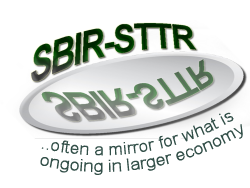
| |
 Collaboration -- not competition -- is the heart of innovation. Partnering with other companies is what..make(s) innovative ideas...successful Collaboration -- not competition -- is the heart of innovation. Partnering with other companies is what..make(s) innovative ideas...successful 
Ilya Pozin, INC Magazine January 19, 2016
|
In today's fast-changing business environment, the notion that rival firms -- fierce competitors in one market setting can be collaborators in another -- s unremarkable; that it is now almost commonplace that corporations (large and small) from entirely different areas of technology emphasis can - and often do - now work together with useful, sometimes important outcomes to all parties.
Anchored in what is arguably the most comprehensive overview of the entirity thatis the SBIR community that the idi systems provide us, we would suggest that, at its most effective
SBIR works for those who understand from their earliest program
involvement that rewards come primarily to those whose
Business Plans are anchored in collaborative effort
But in the mid-1970's through early 80's when the notion of a federally funded, small high-tech business R&D effort was broached, the effort met considerable resistance. That SBIR advocates would suggest that
- not only were small firms capable of often sophisticated and important technology-based endeavor
- but that many would successfully partner with Major and Mid-sized Corporations to the mutual advantage of both parties,
that not-a-few SBIR Awardees c/would become large firms in their own right and leading layers in their space, it was tantamount to heresy.

It is not that small firms got smarter OR that the (now) $46B in SBIR-STTR Award dollars has been enough to achieve the objective. It is that over the THREE plus decades since the controversial passage of the SBIR enabling legislation, the World of Business has radically changed. Elsewhere in this site, the data and analyses are set out that demonstrate the extraordinary range and diversity of what SBIR funded firms have accomplished individually and collectively. Here the effort is to set in context some of how that came about to make SBIR-STR involved firms arguably the
largest single concentration of technical talent inthe Uninted States.
By careful design, from the outset SBIR was never about enabling small firms to take on the type of basic, longer term investigatory research judged primarily to be the province of academic and non-profit research institutions. Instead, through a highly competitive process, within the scope and widely differening interests of each participating agency, the primary SBIR focus was on small firms undertaking projects judged by each agency as addressing a
felt, unmet need
- Their own practical concerns in mission agencies and
- in civilian agencies, those of the communities whom they serve
In the context, SBIR was to be less about funding science
as it was about supporting development of the technology.
While the immediate Deliverable would be a Report, the Objective was progress towards in-use condition.
With small firms at that time effectively locked out of federal procurement, the working SBIR premise was effectively one of leverage. The judgment was that using Federal funds - totaling only $36M across all agencies in FY83 -
- to support the early-stage, high-risk work -- the "R" and the "D" -- that few other funding sources would take on
- and to tackle that risk in short-duration stages: Phases I and II
c/would enable progress towards 'de-risking' such project(s). Projects showing promise c/would draw the attention - and access to the relevant resources -- of the Mission Agency(ies) and interested larger Corporations to move from the SBIR Phase II "D" (development) to the second "D" (demonstration) (not SBIR funded) and -- for some - into actual use-condition.
In effect, SBIR was to be less about funding science
as it was about supporting the development of technology
It is striking - and worth noting directly - that Venture Capital
From that premise - and even then not until the Phase II consideration process - Reviewers looked for indication of the rights types of Capital Access, Business and Industry connection by applicants: did they understand what it would take to move the technology to use-condition; did they have the wherewithal to make that happen.
Expressed interest by Financial sources to include (but not exclusively) by Venture Capital; Letters of Support from those with relevant market presence; Evidence of external partnering; any form of in-use presence serve(d), in effect, to validate that the small firm involved might have what it would take, that the work undertaken was passing muster among those whom one might assume should (or might) know.
The Recipient of the federal SBIR Dollar - set to increase in FY15 to 2.9% of extramural R&D budgets of participating agencies - by definition is a Small Firm. Consistent with the intent of those who crafted SBIR, over the life of the program (1983- ) large numbers of Awardees - many with names that are now well-known - have successfully moved their SBIR funded projects from
 Phase I through Phase II: funded by SBIR dollars
Phase I through Phase II: funded by SBIR dollars
 to some form of 'use-condition' at "Phase III": where SBIR dollars explicitly may not be used.
to some form of 'use-condition' at "Phase III": where SBIR dollars explicitly may not be used.
With rare exception. they have done this through various forms of Third Party Engagement.
 |
What the data shows is now very different is that - in
part at least due to changed program management
decisions - that engagement is occurring far earlier
in the SBIR application process. |
| Unintended consequences? |
|
Third party validation always a factor:
now an early requirement |
An early focus in the SBIR Proposal Review process on the Small Firm's Business Plan - in some sources now as early as Phase I - addressing how they are thinking about th 'commercialization' process is changing/has changed the dynamics of the application and award process.
- In striking contrast to the long time condition of VC following SBIR involvement, the major percentage of VC awarded to SBIR Firms recently is to those already having VC before they become SBIR involved. Who better - after all - is likely to have the better Business Development story than a firm which has sucessfuly raised External funding?
- Some otherwise well-qualified companies that in earlier years would likely have been selected for funding are falling behind and/or may actually be opting out of the SBIR opportunity. These would include
- firms with less experienced management
- those in areas of the country having more limited availability of - and acess to - Equity Funding
- those not readily having opportunities to learn first-hand what the increasing number of SBIR interested Larger and Mid-sized Corporations are looking for in their role of Tech Seekers
|
|
By careful design, SBIR was never intended to be another Research funding endeavor. Instead, within the scope and interests of each participating agency, the focus was primarily to be on supporting projects judged by that agency as addressing a felt need - their own in mission agencies; in civilian agencies, by the communities they serve.
Using Federal Funds to support early-stage, high-risk work - the "R" and the "D" - that few other funding sources would take on, the working premise was that, by going some way towards de-risking the project, other sources of follow-on funding - Venture Capital, Large Corporations etc would pick up the baton perhaps during Phase II or certainly subsequently. Selected projects would move from the "D" of development to the second "D" of demonstration and -- for some - into actual use-condition.
SBIR was to be less about funding science as it was
about supporting the development of technology
From that premise - and even then not until the Phase II consideration process - Reviewers looked for indication of the rights types of Capital Access, Business and Industry connection by applicants: did they understand what it would take to move the technology to use-condition; did they have the wherewithal to make that happen.
Expressed interest by Financial sources to include (but not exclusively) by Venture Capital; Letters of Support from those with relevant market presence; Evidence of external partnering; any form of in-use presence serve(d), in effect, to validate that the small firm involved might have what it would take, that the work undertaken was passing muster among those whom one might assume should (or might) know.
|
============================
Though their SBIR-STTR interests and forms of program engagement may be quite distinctly different, given the extent of important connectedness between them, it is useful to think of the players that are variously involved in the SBIR space as a Community. With Awardees the common element, others which make up this community include
- SBIR Awardees: Current, former and applicant
- Participating Federal Agencies: Program Management personnel and others
- State SBIR Support organizations
- Tech Seekers: large and mid-sized firms
- and the range of Professional Service Providers
In this part of the inknowvation.com site the effort is
 To identify with some specificity those who make up each one of these groupings. How we are (probably uniquely) able to do that is discussed below
To identify with some specificity those who make up each one of these groupings. How we are (probably uniquely) able to do that is discussed below
- To varying degrees of detail, to permit those who are Site Registered -- No-Cost as well as Full System Users -- to Search and Sort within that grouping
- AND - potentially very useful and maybe even game-changing - to provide the context, the tools and resources that support and build out on the notion of Community; to allow those having common interests across institutional lines as well a within any grouping, to find and to interact with each other.
.png)
To access the assigned pages for each designated Community Player, simply click on relevant link on right side column of this page.
Each area includes: |
- Description of the particular group with indication of primary role they play in the SBIR space in that capacity
- Provision to Registered Site Users of useful Search and Sort capabilities within that grouping along with interesting aggregate and analytical data -- much of which is not readily available elsewhere...if at all.
|
|
|
.png)
The SBIR-STTR world is replete with awards info and how-to data. Events Calendars - federal, state and others - are full: some providing participants valuable insight.
What is missing are the means to support ongoing interaction between parties: useful, in-depth and timely. To that end, this site |
- Carries broad range of business-development related data: indication of SBIR-impact analysis
- Provision of the tools to initiate and contribute into substantive discussions.
- ....in short business networking at its most effective & useful.
|
|
|

In the very earliest days after having achieved passage of the original SBIR enabling legislation in 1982, to maintain the integrity of the implementation of what was a highly controversial program effort, we began systematically to keep the SBIR record in a single database. Intially focused primarly on following-the-money - which small firms in what state got how many dollars from which agency for what purpose - as database technologies and tools evolved and sources of information opened up, just as systematically we expended the effort also
- to track a range of related information about awardees
- and, by extension, to compile considerable data and to make the connections to these other players who make up the SBIR Community.
This effort - and the powerful analytical systems it has made possible 
- served well to support the political process of several Reauthorizations: in 1986, in 1992, in 2000 and - though to a much lesser extent since the effort was far less about the facts - the most recent effort which continued relentlessly from 2008 through last year.
- could be a very powerful and effective resource in setting the agenda to achieve the next Reauthorization in timely and appropriate manner well in advance of the September 30, 2017 end of the current SBIR enabling legislation.
More recently, use of the systems has broadened pro-actively to support
- making the right connections between those in Large and Mid-Sized firms with outreach responsibility to find appropriately skilled Partners from among the SBIR community. Designated ASSETs, this is in fact the primary business of the Innovation Development Institute and has already enabled more than $250M of transactions to date
- interested Agency personnel and State SBIR Support better to understand - and make use of -
- the extent and form of SBIR involvement in other agencies of their current awardees
- and more fully to profile the background and present business condition of the same
 Using these data now to enable more effective draw-down of some of the SBIR value created by focusing on documenting the overall achievement of SBIR as a Community is the next logical next step. Also making possible the development of what could be an interesting and potentially useful a social/business networking capability is a major bonus
Using these data now to enable more effective draw-down of some of the SBIR value created by focusing on documenting the overall achievement of SBIR as a Community is the next logical next step. Also making possible the development of what could be an interesting and potentially useful a social/business networking capability is a major bonus
